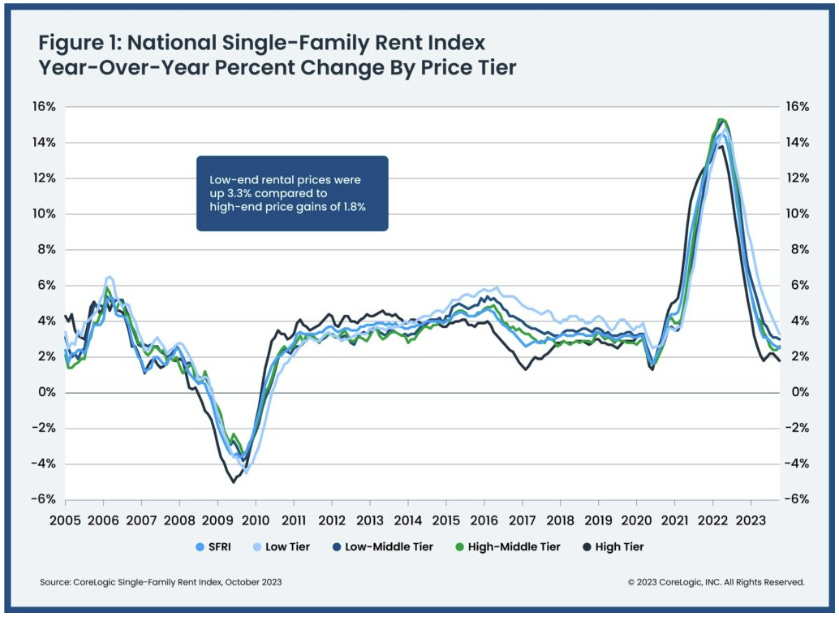Asking Rents Mostly Unchanged Year-over-year
Tracking rents is important for understanding the dynamics of the housing market. For example, the sharp increase in rents helped me deduce that there was a surge in household formation in 2021 (See from September 2021: Household Formation Drives Housing Demand).
The surge in household formation has been confirmed (mostly due to work-from-home), and this led to the supposition that household formation would slow sharply in 2023 (mostly confirmed) and that asking rents might decrease in 2023 on a year-over-year basis (now negative year-over-year).
Recent data suggests household formation has slowed sharply and asking rents are mostly unchanged year-over-year. With a near record number of multi-family units under construction, slow household formation, rising vacancy rates, and soft rents, most builders expect to start fewer multi-family units in 2024.
First, a survey of rent reports …
Apartment List: Asking Rent Growth -1.0% Year-over-year
From ApartmentList.com: Apartment List National Rent Report
Happy New Year and welcome to the January 2024 Apartment List National Rent Report! The rental market closed out 2023 with a fifth straight month of negative rent growth, as the nationwide median rent fell by 0.8 percent to $1,379. The recent declines are in line with the rental market’s typical seasonal pattern, as fewer renters are looking to move at this time of year, although this year’s dip has been a bit sharper than what we normally see.
Year-over-year rent growth has bottomed out but remains in negative territory at -1 percent, meaning that on average, apartments across the country are slightly cheaper today than they were one year ago. This stands in sharp contrast to the prevailing conditions of 2021 and 2022, when rent prices were surging and year-over-year growth peaked at 18 percent nationally. But despite this cooldown, the national median rent is still nearly $250 per month higher than it was just three years ago. …
December’s decline was a bit more modest than the 1 percent dip that we saw in November. But this is also the second steepest December rent decline that we’ve seen in the history of our index (going back to 2017). The only time that December brought a sharper decline was in 2022, when rents fell by 0.9 percent as the market shifted into the period of sluggishness that still persists. For comparison, from 2017 to 2020, December declines averaged 0.3 percent.
On a year-over-year basis, rents nationally are down 1 percent. Year-over-year rent growth fell to zero in June for the first time since the early stages of the pandemic, and has now been in negative territory for seven consecutive months. …
[A]fter bottoming out in October 2021, our national vacancy index has been easing steadily for two full years. This easing has plateaued in recent months, but has not stopped entirely. In December, our vacancy index ticked up to 6.5 percent, the highest reading since September 2020. And there’s good reason to expect that it could rise even further in the year ahead. …
emphasis added
Realtor.com: Seventh Consecutive Month with Year-over-year Decline in Rent
From Realtor.com: November 2023 Rental Report: Rent Prices Fall for Seventh Consecutive Month
In November 2023, the U.S. median rent continued to see a year-over-year decline for the seventh month in a row, down -0.6% for 0-2 bedroom properties across the top 50 metros, a pace similar to the -0.5% seen in October. The median asking rent was $1,717, down by $12 from last month and $59 less from the peak seen in July 2022. However, it was still $313 (22.3%) higher than the same time in 2019 (pre-pandemic).
CoreLogic: “18th consecutive month” of Deceleration
CoreLogic also tracks rents for single family homes: CoreLogic: US Single-Family Rent Growth Continues to Soften in October
U.S. single-family rental prices were up by 2.5% year over year in October, marking the 18th straight month of annual deceleration. …
“Single-family rent increases continued to moderate in October, slowing to the lowest annual growth rate in more than three years,” said Molly Boesel, principal economist for CoreLogic. “In addition, this marked the largest drop between September and October in more than a decade. While slowing rent growth is welcome news for tenants, affordability has suffered over the past few years, with median single-family rents increasing by about $500 nationally since February 2020.”
The 2.5% YoY increase in October was down from 2.6% in September.
Real Page: “Effective asking rents inched up 0.16% year-over-year”
From Jay Parsons at Real Page: Apartment Rents Remain Flat, and Could Be for a While
Apartment rent growth has been rapidly cooling off since peaking in March 2022. But that trend could be leveling off – at least for now.
Effective asking rents inched up 0.16% year-over-year nationally as of November 2023, compared to 0.08% in October, with change measured on a same-store basis. That marked the first time in 20 months that the pace of rent change did not decelerate. But it’s also highly unlikely to signal a meaningful re-acceleration. RealPage continues to expect rent growth to remain fairly flat through 2024, with many markets posting cuts.
Rent Data
Here is a graph of several measures of rent since 2000: OER, rent of primary residence, Zillow Observed Rent Index (ZORI), ApartmentList.com and CoreLogic Single Family Rental Index (All set to 100 in January 2017)
Keep reading with a 7-day free trial
Subscribe to CalculatedRisk Newsletter to keep reading this post and get 7 days of free access to the full post archives.








